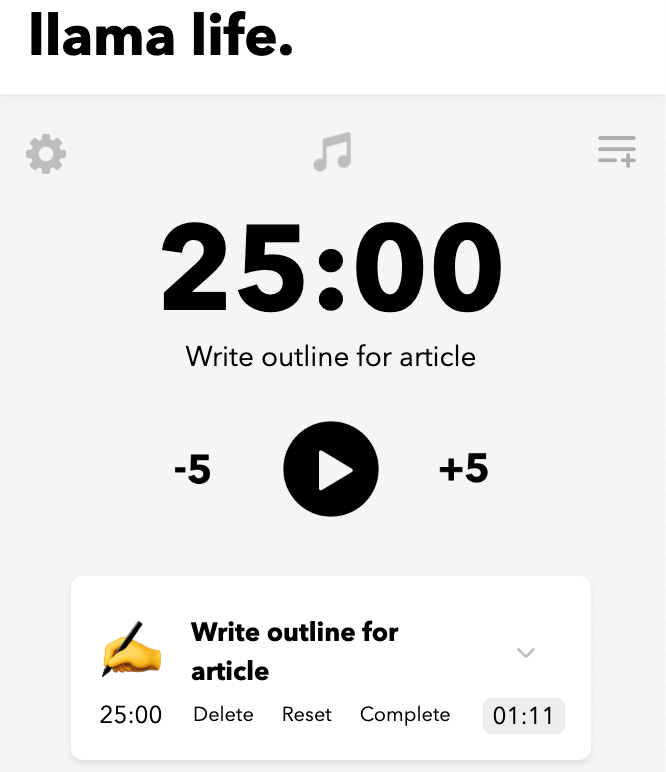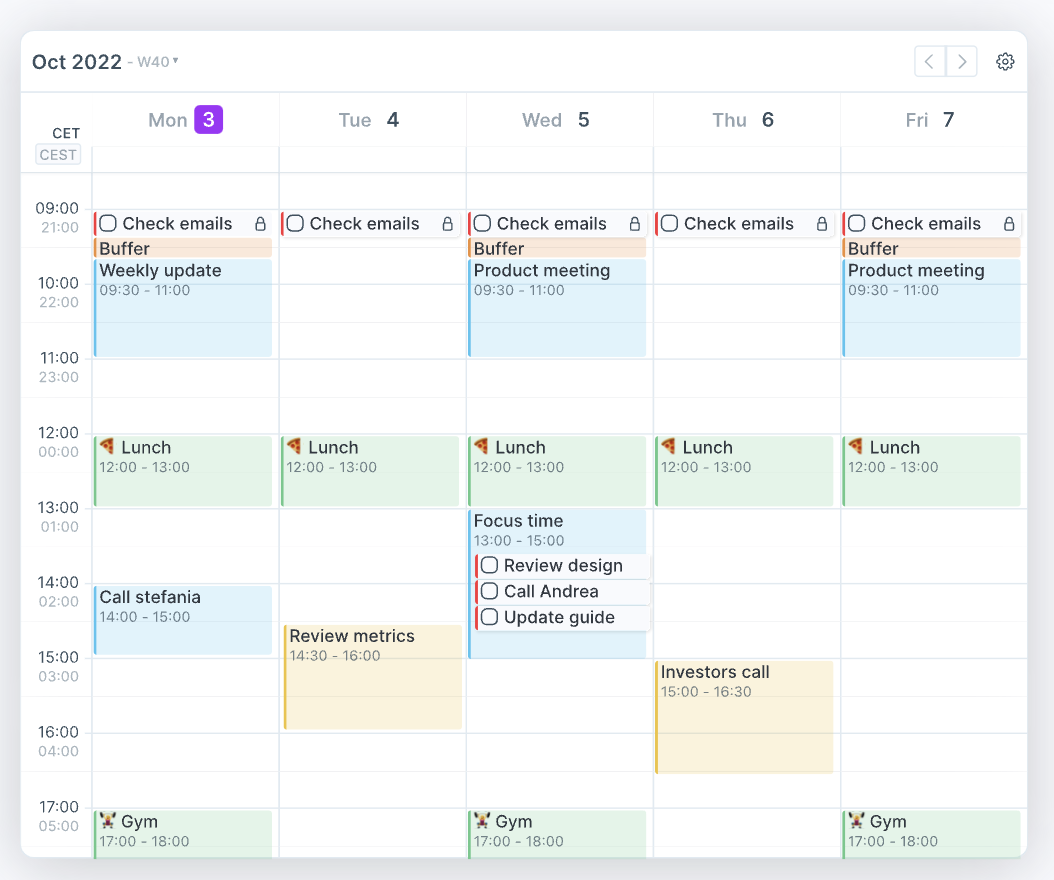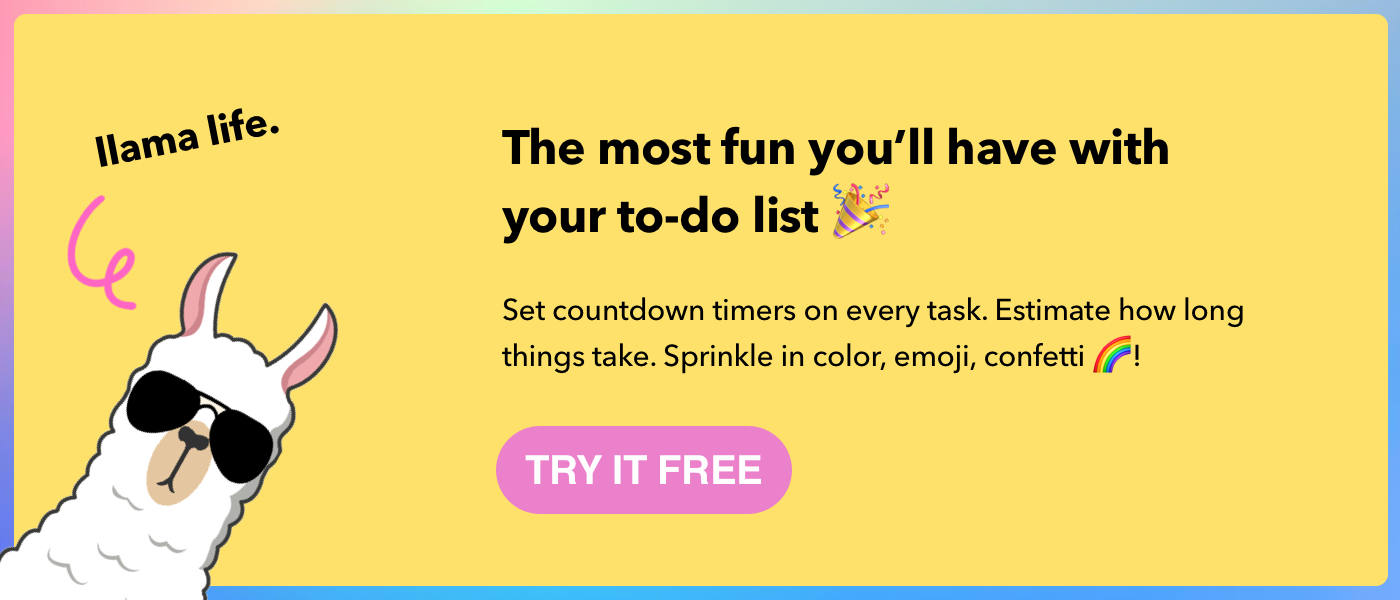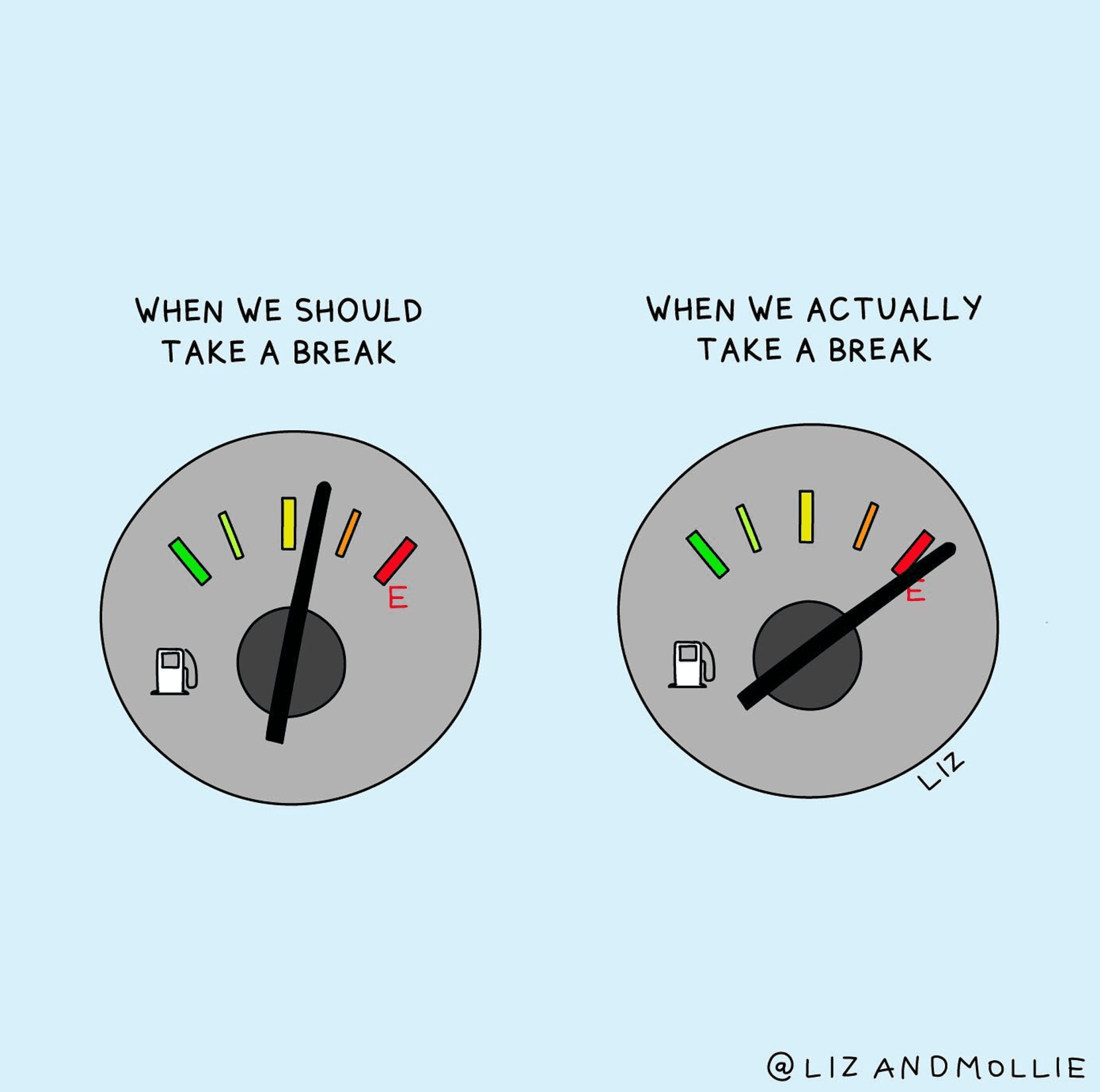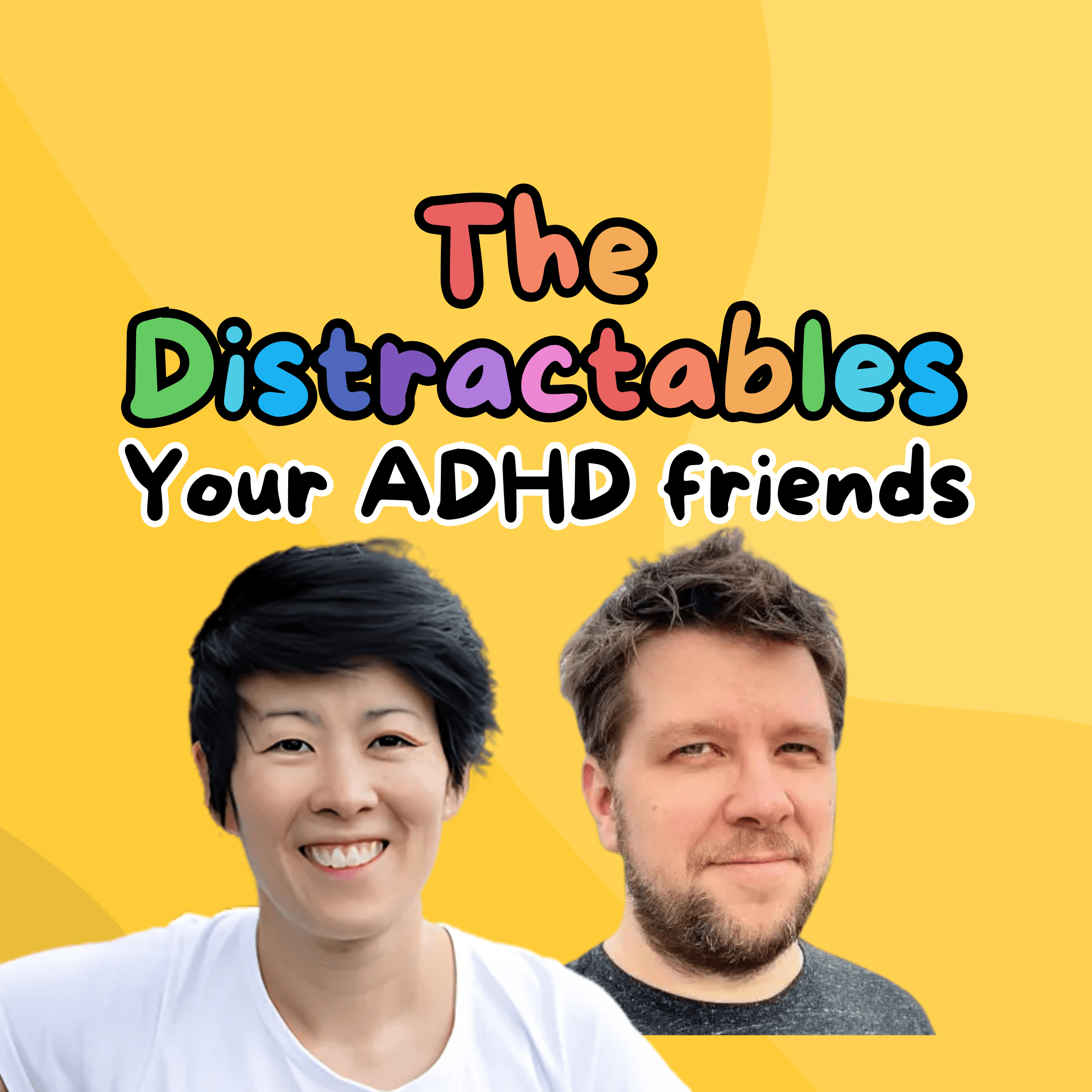What is timeboxing?
Timeboxing is a time management technique that involves setting a time limit for how long you will work on a task, and then timing yourself while you work on it.
For example, if you need to write an outline for an article, you could 'timebox' that task by saying you will only work on it for 25 minutes.
To timebox it, you would set a timer for 25 minutes and when the timer goes off you would force yourself to consider the task done and move on to the next task.
(Here is an example of how you can timebox a task using Llama Life).
When done correctly, timeboxing can be a game changer for productivity and time management, especially for people with ADHD. Let's explore why.
6 benefits of timeboxing that will boost your productivity
Here are 6 ways that the timeboxing technique helps to boost productivity:
- Creates urgency: You’ve decided on the amount of time dedicated to the task. You’ve started the timer. Seeing the timer count down can create a sense of urgency causing you to start on the task right away (vs procrastinating any longer)
- Helps you prioritize tasks: By setting a timer for each task, you can get a better idea of what you can get into in a single day, and prioritize your to-do list accordingly.
- Helps you avoid spending too much time on one task: We can all go down rabbit holes sometimes and can spend too much time on one task. Timeboxing tools like Llama Life have an alarm that goes off at the end of the timer, reminding you it's time to switch to the next task.
- Better understanding of how long tasks take: With every task you timebox, you will gain a better understanding of the time needed to complete it. This will mean better time estimates for future tasks and more successful timeboxing!
- Better clarity across your calendar and schedule: Timeboxing your tasks mean you’ve considered priorities, determined when you’re working on them, and for how long. This will create a clearer understanding of your schedule.
- More efficient meetings: If you often find meetings run over time, it may be a good idea to timebox the meeting agenda. Use a tool to track time (like Llama Life), once that allocated time is up, move to the next topic. It's important to first set this precedence at the beginning of the meeting to ensure everyone is on the same page.
Why timeboxing is an especially effective time management technique for ADHD
People with ADHD can struggle with procrastination, hyperfocus, and timeblindness. Here are 3 ways timeboxing can help mitigate those ADHD challenges:
- Helps avoid hyperfocus: Hyperfocus, the tendency to be completely engaged in something, can often be a positive thing. For instance, if the task you're hyperfocused on is your highest priority task, it'll receive your full focus and attention. However, hyperfocus can also be detrimental if the task you're hyperfocused on is not the best use of your time (like say, cat videos on Youtube). In the latter case, timeboxing with a task timer can be a life saver because when the alarm goes off, it's a chance to reset and consider if you're spending your time on the right thing.
- Reduce's procrastination: Because timeboxing creates a sense of urgency, it can help people with ADHD manage their procrastination. Once the timer starts, it's time to work!
- Effective timeboxes helps to improve concept of time and reduce time blindness: We talked about how timeboxing can improve your understanding of how long tasks will take. This is especially helpful for people with ADHD who experience timeblindness, or a lack of understanding of how long things take.
Time blocking vs timeboxing – what is the difference?
Timeboxing often gets confused with time blocking because both are very popular time management techniques that create a positive time constraint.
So, let's break it down–what is time blocking and how is it different?
What is time blocking?
Time blocking is a time management method where you schedule specific time frames (or blocks!) on your calendar for individual tasks, or set of tasks, with clear starting and finishing time constraints. Your day may be made up of numerous time blocks.
Sounds simple enough, right?
Source: Akiflow
6 ways time blocking is good for productivity
- Increased focus: time blocking requires you to focus on one task or one type of tasks for each time block, which can reduce the productivity costs of context switching, distractions, and multitasking.
- Better prioritization: time blocking helps you to prioritize tasks by allocating specific blocks of time for the most important and time sensitive activities. This can help you to stay on top of deadlines and ensure that you're working on the most important tasks at the right time
- Improved organization: time blocking allows you to organize your day in a structured way, which can make it easier to manage your time and stay on top of your to-do list
- Reduced stress: with time blocking, you can plan your day in advance and have a clear idea of what needs to be done, which can reduce stress and anxiety
- Track progress: by time blocking, you can look back on your calendar and see how long you spent on certain tasks
Time blocking or timeboxing, which one is better?
Parkinson's Law describes a phenomenon that work expands to fill the time allotted for it. In other words, if you have 3 hours to complete a task, it will take 3 hours. But if you only have 10 minutes, it will take 10 minutes.
Timeboxing and time blocking both protect you against Parkinson's Law. By committing to a strict time limit of how long to spend on a task, you are proactively protecting against the task taking up more and more time, even if it could have been done in a shorter amount of time.
In other words, timeboxing and time blocking increase the chances that you finish the task in a shorter amount of time than you would have without timing it.
However, they are very different techniques and each have their own utility for different people and types of tasks.
Timeboxing is a great time management strategy for people with ADHD
For instance, many Llama Life community members, in particularly those with ADHD, say they prefer timeboxing because:
- timeboxing isn't as rigid as time blocking, which is important for people with ADHD who may need to choose a task based on what is interesting to them at the time, rather than what their calendar says
- it can help create the urgency that ADHDer's can need to engage in a task (why a lot of people with ADHD report that they perform best when under tight timelines)
So if you have ADHD or suspect you do, timeboxing may be the better time management technique for you.
Timeboxing may also be for you if you:
- have a constantly changing schedule
- value flexibility and spontaneity
- experience time blindness or have trouble estimating how long things will take
- thrive under pressure
Time blocking is great if you love structure and thrive on routine
Time blocking can be great for those of us who thrive in conditions of structure and predictability.
Time blocking might be for you if you:
- live by your calendar or like to plan every hour of your day
- thrive in predictable and structured environments
- have a lot of time sensitive or strict deadlines for tasks
2 drawbacks of timeboxing to consider before trying it
As with anything, there are some drawbacks to consider. A few potential drawbacks of timeboxing:
- Not great for large tasks: timeboxing may not be great for open-ended tasks or big chunks of work because it might be difficult to stick to your time frame of individual time boxes. This is why it's best to break down larger tasks into smaller tasks first.
- Low-quality work: the quality of your work may be sacrificed as the focus has shifted to finishing within the strict time limit. if this is the case, you can consider 'soft timeboxing', where you don't necessarily have to stop working when the timer goes off, but just use it as a check-in.
3 drawbacks of time blocking to consider before trying it
Time blocking isn't for everyone. Here are 3 main drawbacks of time blocking:
- Inflexibility: time blocking requires a certain level of discipline and structure, which can be difficult to maintain if your schedule is constantly changing or if you're dealing with unexpected interruptions all the time. It can also be difficult to adjust to unexpected events, such as a meeting running longer than expected, which can throw off your entire schedule for the day
- Over-scheduling: If you're not careful, time blocking can lead to over-scheduling, where you try to fit too many tasks into too little time. This feeling of having a lack of time can cause stress and burnout, and can make it difficult to accomplish anything
- Lack of spontaneity: Time blocking can be rigid, and if you follow it too strictly, you may find that you have little time for spontaneous activities or for taking even a 5 minute break during the day
Best apps for time blocking
If you’re looking to boost productivity through time blocking, we recommend a task timer that integrates a calendar view.
We’ve found a few that may be worth trying out:
- Akiflow: Akiflow is a versatile time management tool that aids in increasing productivity by organizing tasks and scheduling time effectively.
- Sunsama: Transform your work-life balance from a dream to reality with Sunsama, the digital daily planner that promotes serenity and concentration. Take control of your schedule and purposefully allocate your time using a guided, step-by-step routine.
- Toggl: Toggl is an application for timeboxing that empowers you to keep a record of your time and improve your productivity. It boasts a user-friendly, uncluttered interface that facilitates easy usage and is loaded with numerous functionalities to assist you in accomplishing more tasks in a shorter period of time.
- Fantastical: If you're in search of a more advanced calendar and time-management application, look no further than Fantastical. Its user-friendly design draws inspiration from the native macOS Calendar and Reminders apps, but with an emphasis on convenience and a more intuitive natural language input.
Imagine you have a deadline coming up, and you need to plan your time accordingly.
With a time tracker that has a calendar view feature, you can easily see how much time you have available and plan your tasks accordingly.
For instance, you could schedule your tasks around your meetings and appointments, ensuring that you have enough time to complete everything on time.
Best task timer apps for timeboxing
Llama Life!
If you're looking for a task timer to use for timeboxing that's both fun and effective, Llama Life is the one for you. It's a productivity tool designed specifically for timeboxing that allows you to create a custom timer for each task and achieve mindful productivity as a result.
And because the founder has ADHD herself, it's designed with the common struggles of ADHD in mind, like time blindness, procrastination, and hyperfocus.
Other features include brown noise to help with focus, a visual pie timer/digital timer, custom colors, and a cute llama mascot (Lulu!).
Choose the time management strategy that is right for you
Both time blocking and timeboxing have their advantages and disadvantages! Only you can decide which method works best for your needs, preference and how your brain works.
Just remember to give yourself some time to try out and experiment with different techniques. It can be hard to get started with a new time management strategy and it will take some time and effort to make any changes.
So go slowly, try to timebox or time block one task first, then two, then expand from there.
